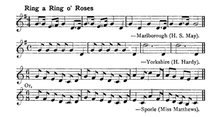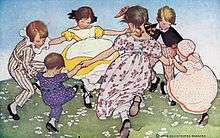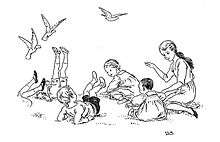Ring a Ring o' Roses
| "Ring a Ring o' Roses" | |
|---|---|
 Melodies for "Ring a Ring o' Roses", Alice Gomme, 1898.[1] | |
| Nursery rhyme | |
| Published | 1881 |
|
Audio samples | |
"Ring a Ring o' Roses" or "Ring a Ring o' Rosie" is a nursery rhyme or folksong and playground singing game. It first appeared in print in 1881, but it is reported that a version was already being sung to the current tune in the 1790s and similar rhymes are known from across Europe. It has a Roud Folk Song Index number of 7925. Urban legend says the song originally described the plague, specifically the Great Plague of London, or the Black Death, but folklorists reject this idea.[2]
Lyrics

It is unknown what the earliest version of the rhyme was or when it began. Many incarnations of the game have a group of children form a ring, dance in a circle around a person, and stoop or curtsy with the final line. The slowest child to do so is faced with a penalty or becomes the "rosie" (literally: rose tree, from the French rosier) and takes their place in the center of the ring.
Variations, corruptions, and vulgarized versions were noted to be in use long before the earliest printed publications. One such variation was dated to be in use in Connecticut in the 1840s.[3]
Common British versions include:
Ring-a-ring o' roses,
A pocket full of posies,
A-tishoo! A-tishoo!
We all fall down.[4]
Cows in the meadows
Eating buttercups
A-tishoo! A-tishoo!
We all jump up.
Common American versions include:
Ring-a-round the rosies,
A pocket full of posies,
Ashes! Ashes!
We all fall down.[4]
.jpg)
Common Indian versions include:
The last two lines are sometimes varied to:
Hush! Hush! Hush! Hush!
We've all tumbled down.[4]
Early attestation

A reference to a young children's game named Ring o' Roses occurs in an 1846 article from the Brooklyn Eagle. A group of young children (the eldest being about seven) form a ring, from which a boy takes out a girl and kisses her.[7]
An early version of the rhyme occurs in a novel of 1855, The Old Homestead by Ann S. Stephens:
A ring – a ring of roses,
Laps full of posies;
Awake – awake!
Now come and make
A ring – a ring of roses.[8]
The novel goes on to describe a nineteenth-century Fourth of July celebration by children housed in a hospital in Roosevelt Island, New York (then known as "Blackwell's Island"): 'Then the little girls began to seek their own amusements. They played "hide and seek," "ring, ring a rosy," and a thousand wild and pretty games'.[9]
Another early printing of the rhyme was in Kate Greenaway's 1881 edition of Mother Goose; or, the Old Nursery Rhymes:
In 1882, Godey's Lady's Book has the following version:
Ring around a rosy
Pocket full of posies.
One, two, three—squat![11]
Before the last line, the children stop suddenly, then exclaim it together, "suiting the action to the word with unfailing hilarity and complete satisfaction".[11]
In his Games and Songs of American Children (1883), William Wells Newell reports several variants, one of which he provides with a melody and dates to New Bedford, Massachusetts around 1790:
Ring a ring a Rosie,
A bottle full of posie,
All the girls in our town
Ring for little Josie.[3]
Newell writes that '[a]t the end of the words the children suddenly stoop, and the last to get down undergoes some penalty, or has to take the place of the child in the centre, who represents the "rosie" (rose-tree; French, rosier).'[3]
An 1883 collection of Shropshire folk-lore includes the following version:
A ring, a ring o' roses,
A pocket-full o' posies;
One for Jack and one for Jim and one for little Moses!
A-tisha! a-tisha! a-tisha![12]
On the last line "they stand and imitate sneezing".[12]
A manuscript of rhymes collected in Lancashire at the same period gives three closely related versions, with the now familiar sneezing, for instance:
A ring, a ring o' roses,
A pocket full o' posies-
Atishoo atishoo we all fall down.[13]
In 1892, folklorist Alice Gomme could give twelve versions.[14]
Other languages

A German rhyme first printed in 1796 closely resembles "Ring a ring o'roses" in its first stanza[15] and accompanies the same actions (with sitting rather than falling as the concluding action):[16]
Ringel ringel reihen,
Wir sind der Kinder dreien,
sitzen unter'm Hollerbusch
Und machen alle Husch husch husch!
Loosely translated this says "Ringed, ringed row. We are three children, sitting under an elder bush. All of us going hush, hush, hush!" The rhyme is well known in Germany with the first line "Ringel, Ringel, Reihe" (as the popular collection Des Knaben Wunderhorn gave it); it has many local variants, often with "Husch, husch, husch" (which in German could mean "quick, quick") in the fourth line,[17] comparable to the "Hush! hush! hush! hush!" of the first printed English version. This popular variant is notable:[18]
Ringel, Ringel, Rosen,
Schöne Aprikosen,
Veilchen blau, Vergissmeinnicht,
Alle Kinder setzen sich!
The translation is "A ring, a ring of roses. Beautiful apricots. Blue violets, forget-me-nots. All children sit down."
Swiss versions have the children dancing round a rosebush.[19] Other European singing games with a strong resemblance include "Roze, roze, meie" ("Rose, rose, May") from The Netherlands with a similar tune to "Ring a ring o' roses"[20] and "Gira, gira rosa" ("Circle, circle, rose"), recorded in Venice in 1874, in which girls danced around the girl in the middle who skipped and curtsied as demanded by the verses and at the end kissed the one she liked best, so choosing her for the middle.[21]
In Croatian/Serbian/Bosnian language, there is a similar rhyme called "Ringe Ringe Raja":
Ringe-ringe-raja,
Doš'o čika Paja,
Pa pojeo jaja.
Jedno jaje muć,
A mi, djeco, čuč!
A rough translation is "Ringe Ringe Raya (doesn't mean anything, this is common in Croato-Serbian rhymes), uncle Ducky has came, and he ate all the eggs, one egg crashed, and we children squat!" On the last word, the children singing the rhyme jump or squat.
Meaning

The origins and meanings of the game have long been unknown and subject to speculation. In 1898, A Dictionary of British Folklore contained the belief that an explanation of the game was of pagan origin, based on the Sheffield Glossary comparison of Jacob Grimm's Deutsche Mythologie. The theory states that it is in reference to Pagan myths and cited a passage which states, "Gifted children of fortune have the power to laugh roses, as Freyja wept gold." Believing the first instance to be indicative of Pagan beings of light. Another suggestion is more literal, that it was making a "ring" around the roses and bowing with the all "fall down" as a curtsy.[22] In 1892, the American writer, Eugene Field wrote a poem titled Teeny-Weeny that specifically referred to fey folk playing ring-a-rosie.[23] According to Games and Songs of American Children, published in 1883, the "rosie" was a reference to the French word for rose tree and the children would dance and stoop to the person in the center.[3] Variations, especially more literal ones, were identified and noted with the literal falling down that would sever the connections to the game-rhyme. Again in 1898, sneezing was then noted to be indicative of many superstitious and supernatural beliefs across differing cultures.[22]
Since the 20th century, the rhyme has often been associated with the Great Plague which happened in England in 1665, or with earlier outbreaks of the Black Death in England. Interpreters of the rhyme before the Second World War make no mention of this;[24] by 1951, however, it seems to have become well established as an explanation for the form of the rhyme that had become standard in the United Kingdom. Peter and Iona Opie, the leading authorities on nursery rhymes, remarked:
The invariable sneezing and falling down in modern English versions have given would-be origin finders the opportunity to say that the rhyme dates back to the Great Plague. A rosy rash, they allege, was a symptom of the plague, and posies of herbs were carried as protection and to ward off the smell of the disease. Sneezing or coughing was a final fatal symptom, and "all fall down" was exactly what happened.[25][26]
The line Ashes, Ashes in colonial versions of the rhyme is claimed to refer variously to cremation of the bodies, the burning of victims' houses, or blackening of their skin, and the theory has been adapted to be applied to other versions of the rhyme.[2] In its various forms, the interpretation has entered into popular culture and has been used elsewhere to make oblique reference to the plague.[27]
Folklore scholars regard the theory as baseless for several reasons:
- The plague explanation did not appear until the mid-twentieth century.[21]
- The symptoms described do not fit especially well with the Great Plague.[26][28]
- The great variety of forms makes it unlikely that the modern form is the most ancient one, and the words on which the interpretation are based are not found in many of the earliest records of the rhyme (see above).[2][29]
- European and 19th-century versions of the rhyme suggest that this "fall" was not a literal falling down, but a curtsy or other form of bending movement that was common in other dramatic singing games.[30]
References
- ↑ Gomme, The Traditional Games of England, Scotland, and Ireland, p. 108.
- 1 2 3 Mikkelson, Barbara; Mikkelson, David P. (2007-07-12). "Ring Around the Rosie". Urban Legends Reference Pages. Snopes. Retrieved 2007-01-10.
- 1 2 3 4 Newell, William Wells (1884) [1883]. Games and Songs of American Children. New York: Harper & Brothers. pp. 127–8.
- 1 2 3 Delamar (2001), pp. 38-9.
- ↑ "Ringa Ringa Roses - India". Mama Lisa's World of Children and International Culture. Retrieved 2018-07-18.
- ↑ "Ring a Ring a Roses, Ringa Ringa Roses - Poem Lyrics, Rhymes - Parenting Nation India". www.parentingnation.in. Retrieved 2018-07-18.
- ↑ "Gleanings from the Writings of the late Wm. B. Marsh IV: Twilight Musings". Brooklyn Eagle. 1846-03-17. p. 2.
- ↑ Stephens, Ann S. (1855). The Old Homestead. London: Sampson, Low, Son & Co. p. 213.
- ↑ Stephens, op. cit, pp. 215-216
- ↑ Greenaway, Kate (illustr.) (n.d.) [1881]. Mother Goose, or the Old Nursery Rhymes. London: Frederick Warne and Co. p. 52.
- 1 2 "Games". Godey's Lady's Book and Magazine. Philadelphia. cv (628): 379. October 1882.
- 1 2 Burne, Charlotte Sophia (ed.) (1883). Shropshire Folk-Lore. London: Trübner & Co. pp. 511–512.
- ↑ Opie and Opie (1985), p. 222.
- ↑ Opie and Opie (1951), p. 364.
- ↑ The one commonly sung according to Böhme (1897), p. 438.
- ↑ Böhme (1897), p. 438, Opie and Opie (1985), p. 225.
- ↑ Böhme (1897), pp. 438–41, Opie and Opie (1985), p. 227. Other rhymes for the same game have some similarity in the first line, e.g. "Ringel, ringel, Rosenkranz", less in other lines – see Böhme (1897), 442–5.
- ↑ "Deutsches Kinderlied und Kinderspiel. In Kassel aus Kindermund in Wort und Weise gesammelt von Johann Lewalter" (Kassel 1911), I Nr. 12. Hermann Dunger, "Kinderlieder und Kinderspiele aus dem Vogtlande" (Plauen 1874), p. 320. Böhme (1897)
- ↑ Böhme (1897), p. 439, Opie and Opie (1985), p. 225.
- ↑ Opie and Opie (1985), p. 227.
- 1 2 Opie and Opie (1985), p. 224.
- 1 2 Gomme, George Laurence (1898). A Dictionary of British Folklore. D. Nutt. pp. 110–111.
- ↑ "Children's Column". The Osage City Free Press (Osage City, Kansas). 25 August 1892. p. 6. Retrieved 31 July 2015.
- ↑ Opie and Opie (1985), pp. 221–2.
- ↑ Opie and Opie (1951), p. 365.
- 1 2 Compare Opie and Opie (1985), p. 221, where they note that neither cure nor symptoms (except for death) feature prominently in contemporary or near contemporary accounts of the plague.
- ↑ Opie and Opie (1985), p. 221, citing the use of the rhyme to headline an article on the plague village of Eyam in the Radio Times, 7 June 1973; title of "Ashes" in the New Scientist review.
- ↑ J. Simpson and S. Roud, A Dictionary of English Folklore (Oxford: OUP, 2000), p. 296.
- ↑ Opie and Opie (1985), pp. 222–3: "The following are the seven earliest reports known from in Britain ... In only four of these recordings is sneezing a feature". The point becomes stronger when American versions are also taken into account.
- ↑ See above, and Opie and Opie (1951), p. 365, citing Chants Populaire du Languedoc: "Branle, calandre, La Fille d'Alexandre, La pêche bien mûre, Le rosier tout fleuri, Coucou toupi – En disant 'coucou toupi', tous les enfants quie forment la ronde, s'accroupissent", roughly translated: "The peach well ripe, the rose all blooming, cuckoo humming - When 'cuckoo humming' is said, all the children forming the circle crouch down".
Sources
- Böhme, Franz Magnus (1897). Deutsches Kinderlied und Kinderspiel. Leipzig: Breitkopf & Härtel. pp. 438–445.
- Delamar, Gloria T. (1987). Mother Goose, From Nursery to Literature, Paperback, (2001). Lincoln, Nebraska. pp. 38–39. ISBN 978-0595185771.
- Gomme, Alice Bertha (1898). The Traditional Games of England, Scotland, and Ireland. ii. London: David Nutt. p. 108.
- Opie, Iona; Opie, Peter (1951). The Oxford Dictionary of Nursery Rhymes, 2nd edition (1997). Oxford: Oxford University Press (Nabu Press). pp. 364–365. ISBN 978-0198600886.
- Opie, Iona; Opie, Peter (1985). The Singing Game, Paperback edition (1888). Oxford: Oxford University Press. pp. 221–225, 227. ISBN 978-0198600886.
- Simpson, Jacqueline; Roud, Steve (2000). A Dictionary of English Folklore. Oxford: Oxford University Press. p. 296.